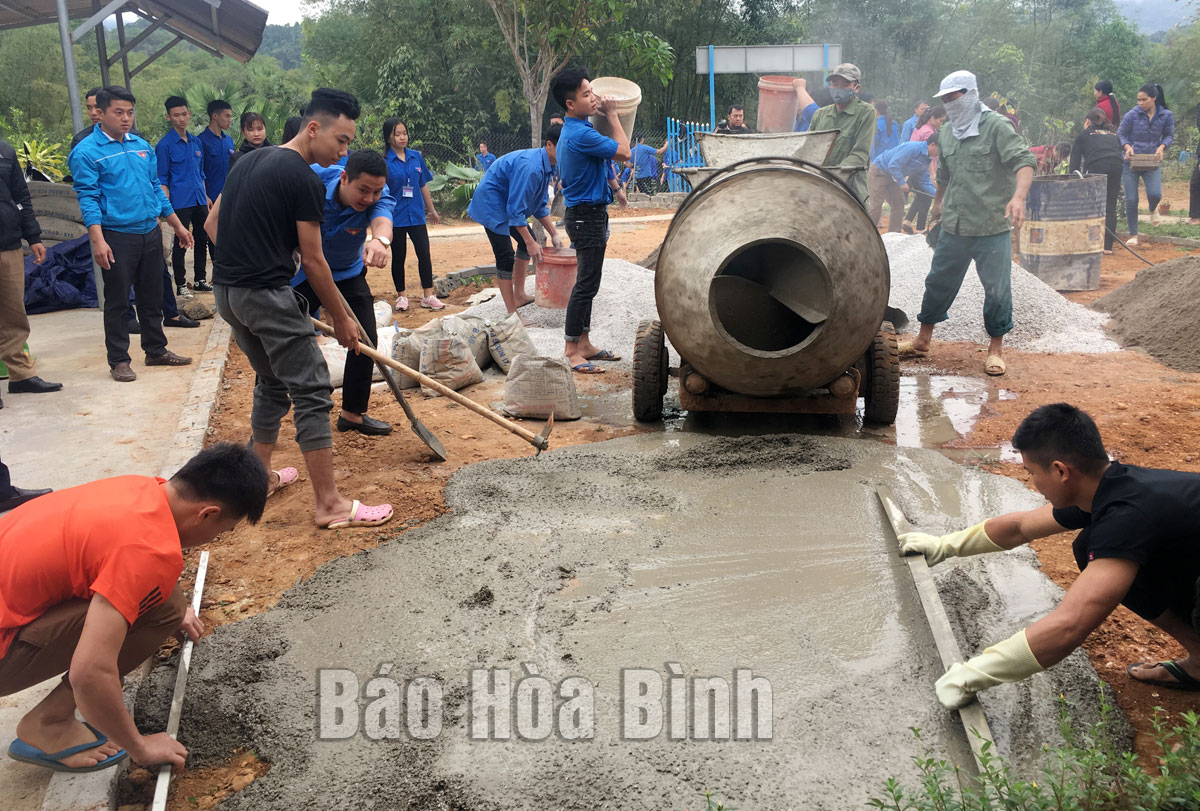
(HBO) – Mai Chau, a mountainous district with 88% of its population being ethnic minority groups, is rolling out comprehensive measures to boost the growth of the agricultural sector and rural areas, and improve the living conditions of local residents.
Locals of Buoc hamlet, Xam Khoe commune
of Mai Chau join hands in constructing rural roads, contributing to promoting
socio-economic development.
Son Thuy is a commune facing extreme difficulties in Mai Chau district.
According to Bui Van Thuy, Secretary of the communal Party Committee, in order
to speed up sustainable development, the locality has strengthened
communications to encourage local residents to switch to developing plants and
livestock with higher economic efficiency.
Bui Van Phuoc from Khan Ha hamlet of Son Thuy commune said that his family has
switched ineffective crop area to the cultivation of sweet potatoes following
VietGAP standards, which generates high values. Therefore, his family’s income
has been improved. So far, many households like Phuoc’s have linked together to
form a cooperative group with a large-scale sweet potato production.
Ha Tuan Hai, head of the Division for Ethnic Affairs of Mai Chau, said that
with the efforts of the whole political system, policies to develop production
among ethnic minority groups and localities with extreme difficulties have been
implemented effectively. As a result, the poverty rate of the locality has
fallen 3-5% each year. Over 60% of the local labourers have receive training,
while the living conditions of local residents have been greatly improved, he
said.
Commenting on the efficiency of policies to support ethnic minority
communities, Chairman of the district People’s Committee Pham Van Hoan said
that the clearest result of the policies is a positive change in the mindset
and practice of local farmers, with the development of crops and livestock
yielding higher economic effectiveness.
The economic situation of local ethnic minority communities has been improved,
and their living conditions greatly enhanced, along with their stronger
confidence in the Party and State, he noted.
Hoan said that in the coming time, effective models and policies to assist the
communities will continue to be promoted and associated with poverty reduction
efforts./.
More than just an information technology teacher, Bui Van Nien is an inspiring figure who has nurtured the scientific curiosity and creative spirit of students in Vietnam’s ethnic minority communities.
Da Bac is the most disadvantaged mountainous district in Hoa Binh province, with ethnic minorities accounting for about 90% of its population. Over the past years, the district has mobilised resources to implement ethnic policies to improve the quality of life of local people.
In recent years, Hoa Binh province has consistently prioritised the protection, care, and education of children, particularly those from ethnic minorities and disadvantaged backgrounds, by creating a safe, healthy, and nurturing environment for their all-round development.
The Steering Committee for Tobacco Harm Prevention and Control of Hoa Binh province, in coordination with the Tobacco Harm Prevention and Control Fund, held a ceremony on May 28 in response to the World No Tobacco Day (May 31) and the National No Tobacco Week (from May 25 to 31). The event was chaired by Nguyen Van Toan, Standing Vice Chairman of the provincial People’s Committee and head of the Steering Committee.
Since 2021, the Center for Industrial Promotion and Industrial Development Consulting (CIIDC) under the Department of Industry and Trade has been implementing a school lighting model as part of the plan for using energy efficiently and economically in Hoa Binh Province in the pẻiod of 2021 - 2025. This model not only aims to improve the learning conditions and enhance the education quality, but it also promotes the message of energy saving, energy security, environmental protection and contributes to the goals of socio-economic development.
In the 2024 - 2025 school year, the entire Hoa Binh provincial education sector includes 520 educational institutions and schools. Among them are 13 ethnic boarding schools with 153 classes and 4,487 students. Four of these schools have met national standards, reaching 30.7 percent.



